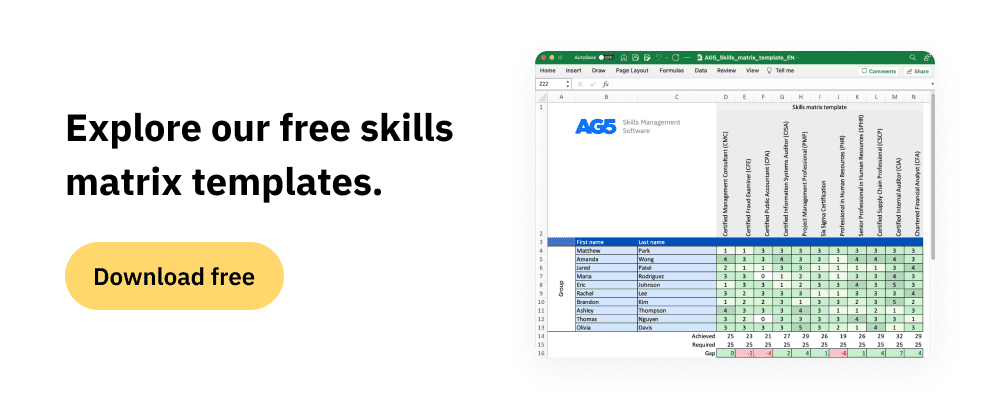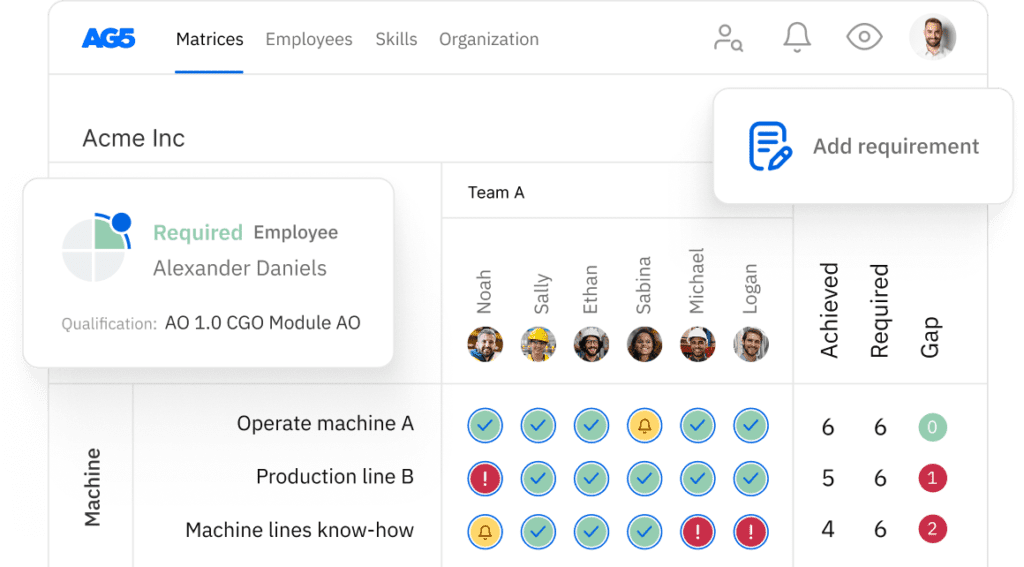What is a training matrix? Definition, benefits & examples
In this article, we’ll explore the ins and outs of training matrices, including their components, how to create them, and their benefits.
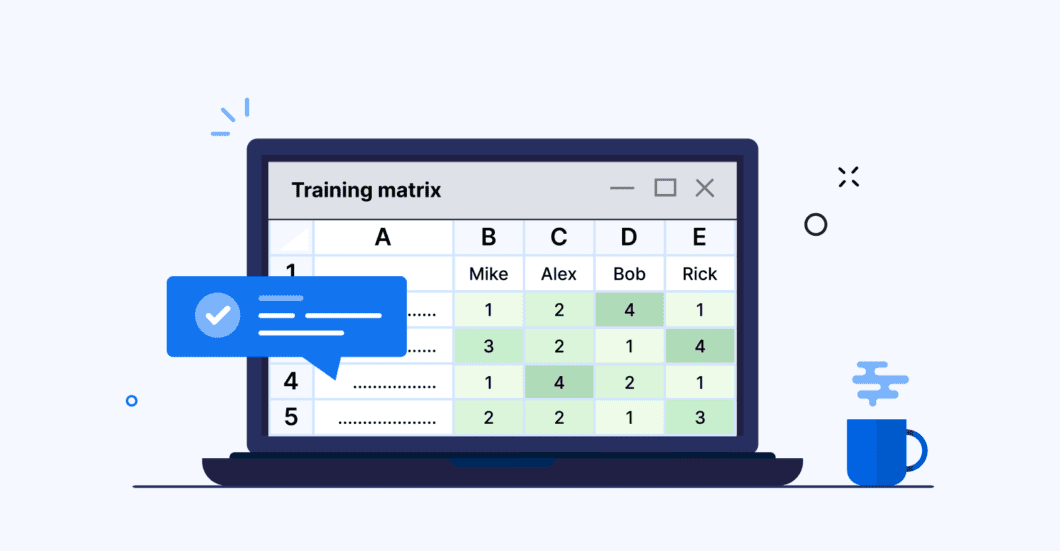
In this article, we’ll explore the ins and outs of training matrices, including their components, how to create them, and their benefits. We’ll also offer free, downloadable examples of training matrices, as well as take a look at how AG5’s skills management software can help you understand and visualize training needs across your organization.
What is a training matrix?Copied
A training matrix is a tool used by organizations to keep track of and identify employee’s training needs. A training matrix can be especially handy in industries that are highly regulated and require frequent renewal of trainings and certifications.
Training matrices typically appear as grids or tables that contain information regarding training activities, the employees who need or have completed these trainings, and other related data. In this way, business or team leaders can ensure that employees are adequately trained by track training progress, as identifying training gaps that must be addressed and filled.
Components of a training matrix
Training matrices usually contain some or all of the following components.
- Training activities or courses. All the training programs or courses in which employees are currently enrolled, as well as those that are required. Examples here include mandatory safety training, specialized technical training, or leadership development workshops
- Employees. The employees who need to undergo these training activities
- Training status. An indication of whether an employee has completed a specific training, is currently undergoing it, or must attend it in the future
- Training dates. The dates when training was completed or is scheduled to take place
- Training providers. The organization or entity responsible for conducting specific training courses
- Skills or competencies developed. The specific skills or competencies that the training aims to develop in employees.
Training matrix vs. skills matrix – What is the difference?
Skills matrices and training matrices can often be used interchangeably, as both tools are used to assess and manage employee capabilities and development within an organization. Both can help companies to keep track of upcoming trainings, and to see who needs to renew certain courses or certifications.
Who can benefit from a training matrix?Copied
Any organization that employs individuals or teams that must undergo training – especially multiple trainings covering a wide range of skills, certifications or qualifications – can benefit from the use of a training matrix.
Industries in which training matrices might prove especially valuable include:
- Manufacturing
- Healthcare
- Information Technology (IT)
- Construction
- Pharmaceutical
- Transportation and logistics
Roles that can benefit from training matrices include training coordinators, team leads, managers, and department leads.
How to create a training matrix in ExcelCopied
Because training matrices and skills matrices are so similar, you can use our “Ultimate guide to creating an Excel skills matrix” to create a training matrix of your own.
When it comes time to populate your matrix, you’ll input all your employee names as described in the guide. However, instead of skills, competencies, qualifiactions, and certifications, you’ll enter the names of trainings that employees have undergone or need.
In “Chapter 3 – Skills matrix scoring systems” of the guide, rather than defining proficiency levels, you’ll assign a numerical value on a scale of one to five for to each employee, based on whether he or she:
- Does not need a training – 1
- Needs a training – 2
- Is undergoing a training – 3
- Has completed a training – 4
- Is able to train others – 5
You can then create an icon set – also outlined in Chapter 3 – based on each of these values.
After that, you can use your training matrix to identify training gaps in exactly the same way you would use a skills matrix to identify skills gaps. This is covered in Chapter 4.
For more on creating a training matrix, you can also read our blog, “Everything you need to know about skills matrices.” You can apply much of what you will learn there in the creation of your own training matrix.
4 free training matricesCopied
Don’t have time to create your own matrix? No worries. You can download and immediately begin using one using one of the below matrices to get started. When you’re ready – and if the need arises – you can return to the above section for help creating a customized Excel-based training matrix.
1. AG5’s skill matrix templates
AG5’s free Excel-based skills matrix templates can help you track skills, certifications, and qualifications related to training across your organization.
We have several options to choose from. For starters, you can read our blog, “5 free skills matrix templates & samples.” There, you’ll find several skills matrices to choose from.
Should you need something more specific, you should use our skills matrix template database, which offers hundreds of pre-populated, industry-specific skills matirces that are completely free to download and use.
2. Smartsheet
Smartsheet [1] offers several variations of training matrices, including a training matrix template, a cross-training matrix template, a construction training template, and a health and safety training template.
You’ll also find brief descriptions of each type of training matrix, as well as a brief overview of how to use them.
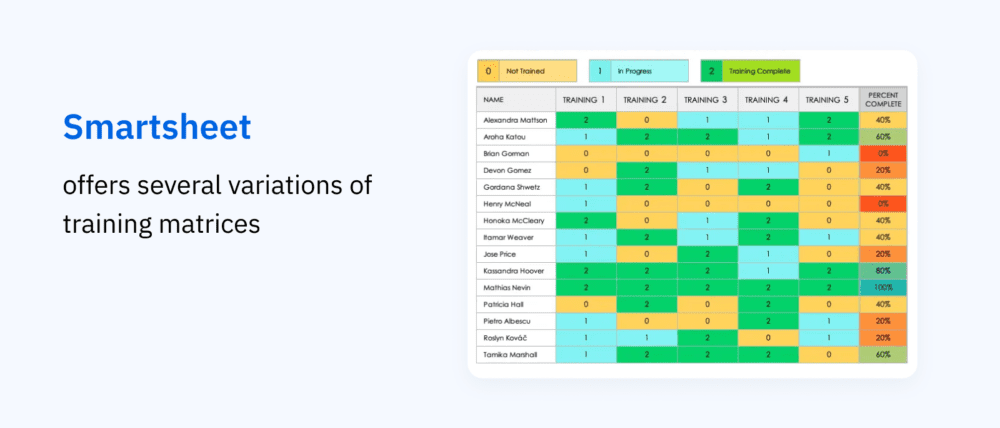
3. Florence
Florence [2] offers software that matches nurses, carers, and support workers with available shifts. It also offers a free training matrix template that features editable, drop-downs for staff names, roles, an editable list of training courses, and color-coded cells that help you track dates for expiring trainings.
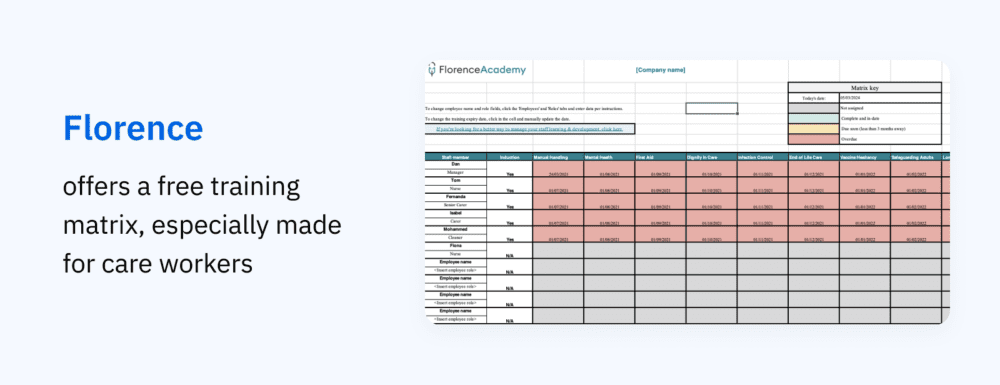
4. Zavvy
Zavvy [3] offers a basic, but very effective free training matrix on its website.
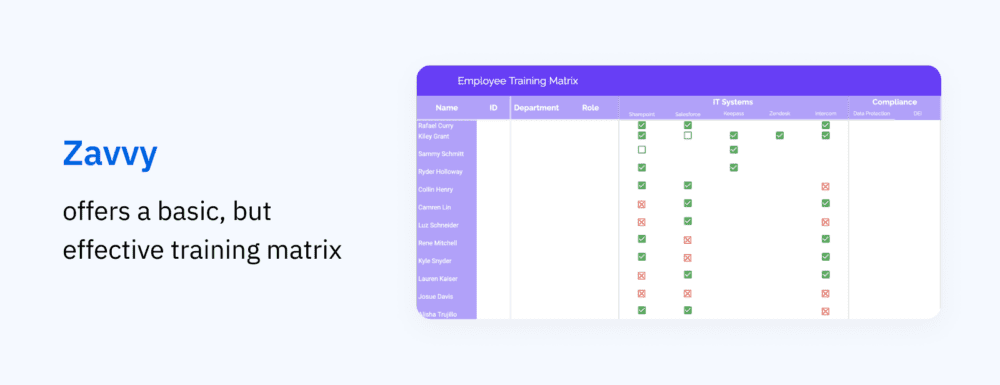
Benefits of a training matrixCopied
Using a training matrix can benefit your organization or teams in a number of ways. Let’s take a look:
- Streamlined communication. Rather than send emails, make phone calls, or schedule meetings regarding employee training, you can use a training matrix to immediately see who has received certain training and who has not, allowing you to quickly and easily find the employees you need for certain tasks.
- Improved compliance. A training matrix helps you ensure that all mandatory trainings are completed by employees, helping your organization stay compliant with industry regulations and standards.
- Skill and training gaps identification. By analyzing your training matrix, you can easily identify areas where employees may need additional development, allowing for targeted training programs to fill these gap.

Challenges of using a training matrixCopied
Creating and implementing a training matrix may also pose a few challenges to your organization. Below, we’ve listed a few of those challenges that we often see our clients face.
- Limitations. A training matrix focuses on training and professional development, and as such it does not allow you to track skills, competencies, and certifications as effectively as you can with a skills matrix.
- Maintenance. Keeping a training matrix up-to-date requires constant attention to changes in training requirements, new courses, and employee progress, which can be time-consuming. This is especially true with Excel-based training matrices, as you will have to manually update them.
- Lack of standardization. Without proper training on how to use a training matrix, there’s a risk that managers or employees may misinterpret data – or input it in a non-standardized way – leading to confusion, errors, and potential training gaps. Again, this holds especially true for Excel-based training matrices.
Accurately predict your training needs with AG5Copied
AG5’s skills management software offers a wealth of resources that help you track skills, qualifications, certifications, and trainings, including skills matrices and training matrices. These matrices move away from spreadsheets to a centralized, standardized platform that can be used across your organization, ensuring everyone is aligned.
With AG5’s training matrix:
- All you have to do is select a period – e.g. the next 12 months – to easily see what qualifications are going to expire in that timeframe
- You’ll enjoy accurate insight into your training needs and the exact budget that is required
- You get the overview you need to plan ahead
- You can identify skill or training gaps per team with a single glance
- You can create automatically updated training plans that all necessary employees can see
Ready to see it in action? Request a free, live, 15-minute demo for a personalized look at how AG5 can transform the way you approach skills and training management.
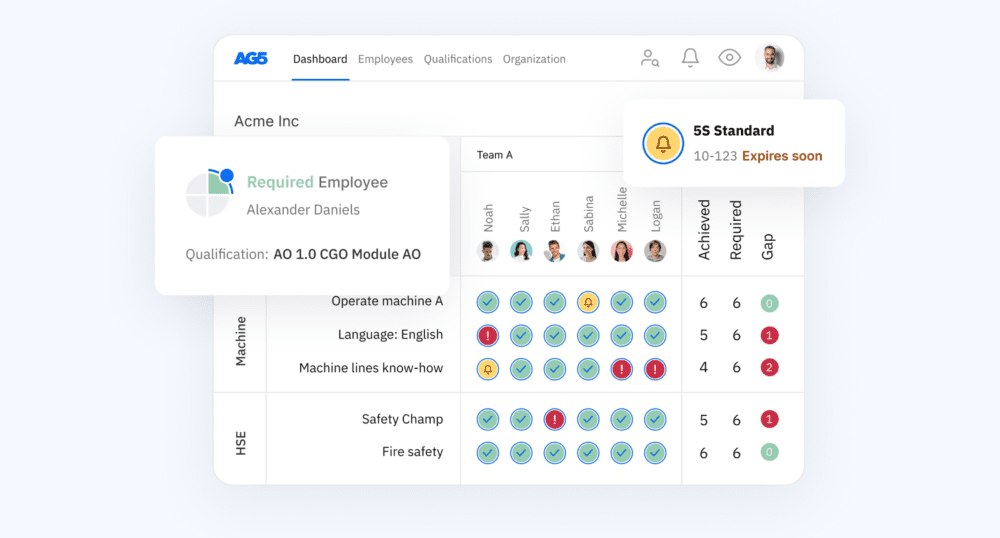
Sources Copied
- Change view: Table
-
APA
| # | Source title | Description | Publication | Retrieved | Source URL |
|---|---|---|---|---|---|
| 1 | Free Training Matrix Templates | Smartsheet | - | April 11, 2024 | https://www.smartsheet.com/con.. |
| 2 | Free training matrix template. | Florence | - | April 11, 2024 | https://www.florence.co.uk/all.. |
| 3 | Training Matrix Template | Zavvy | - | April 11, 2024 | https://www.zavvy.io/downloads.. |
Author Copied
Revisions Copied
Written by: Rick van Echtelt
Copy edited by: Adam Kohut
